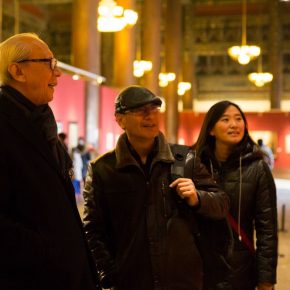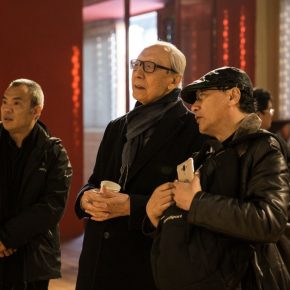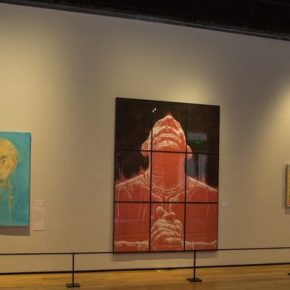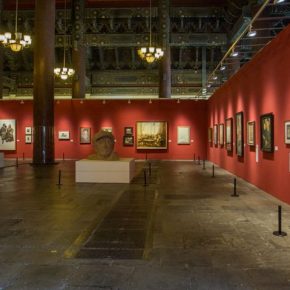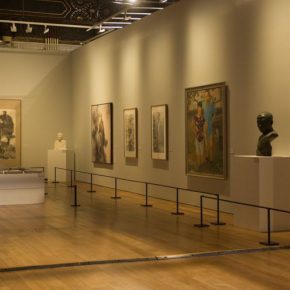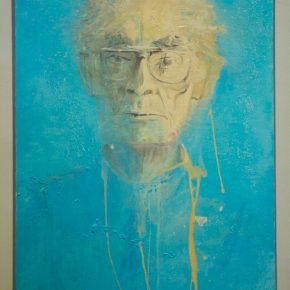
The large-scale exhibition of “Portraits of the Times” assembles the creation of “portraits” by the senior professors, graduates and teachers from CAFA from different periods, covering a variety of art forms, comprehensively presenting the clues and achievements of CAFA in terms of “portrait”. As an artist, Ma Lu’s abstract oil paintings are familiar to the audience and adored by many people. In this exhibition, there features a representational creation of a portrait by Ma Lu, which has rarely been seen before. During the exhibition, CAFA ART INFO interviewed the artist Ma Lu, Dean of the School of Plastic Arts, CAFA, who talked about the experience of his portrait creation and talked about how to understand and interpret the portrait art from historical and practical perspectives. In Ma Lu’s view, the style of portrait is a comprehensive concept, and of a specific figure, and also contains some hidden things that can’t be seen in the painting, such as the understanding of the human object, cultural accomplishment, understanding of the art situation, etc.
Date: January 22, 2018
Venue: China Central Academy of Fine Arts (abbr. CAFA)
Interviewer and copywriter: Zhang Wenzhi
Interviewee: Ma Lu
Translated by Chen Peihua and edited by Sue/CAFA ART INFO
CAFA ART INFO: Hello, Prof. Ma. It is well-known that you are engaged in abstract oil painting, but there features a representational creation entitled “Portrait of Lin Kegong” in the exhibition. It is rare to see your portrait painting, is this piece created for this exhibition? Where does the idea for this creation come from?Ma Lu: I rarely draw a portrait, especially rarely drawing a portrait for a specific person in a very conscious way, but I had an opportunity to create one over the last year. Gallery of China Profiles, Xiamen, wanted to organise a group of portraits of celebrities in Xiamen. The director found me and invited me to draw a portrait of Lin Kegong. Lin Kegong is a Taiwanese painter, who also studied in Europe during the period of the Republic of China, studying in a modernist style like Cezanne. After returning to China, he established a school of fine arts in Gulangyu to fulfill his own ambition. However, the War of Resistance against Japan started after the school had only been established for two years, and he withdrew and moved to Taiwan. Lin was a pioneer of the modern painting movement in Taiwan which started from learning from Cezanne to creating his own modern style. I have created five paintings for this portrait. I wanted to try this because I basically created this in a natural way, and attempted to create an image of the painting by splashing the pigments on the canvas. However, it was extremely difficult to naturally form an human image, especially when it came to the portraying of details.
So I used a combination of thickness and thinness in the painting, thickly drawing the human image and then washed over it with water, so it has a similar feature to my previous creation, but it was not the expected image in the end, and only formed a basic form and texture. I then applied some water-soluble pastels, washed to refine a shape, but it was not powerful so I used some traditional methods to highlight some images on the surface of the painting, so the character and demeanor of the image was portrayed. In terms of composition, I thought Lin Kegong had passed away, so I placed him in the background of the sky, showing the effect of a man floating in the sky. If he is a living person that I am also particularly familiar with, I would not like to draw him in this way, and it became a description of an image in meditation, which is different from our conventional method of portrait creation.
CAFA ART INFO: You just talked about the process and method of creation in this piece, when an audience sees this exhibition, they may have questions, such as how to distinguish and learn about the portrait and figure painting? Because they all depict the image of a character, including many themes, and the human image dominates the screen. At the same time, with the development of technology and culture, especially the advent of photographic image, what impact does it have on the understanding of portrait art?Ma Lu: Figure painting is a concept in Chinese painting. Chinese painting is traditionally divided into three subjects including figures, landscapes, flowers and birds, while the School of Chinese Paining of CAFA is also divided into three departments. However, it found that students’ comprehensive ability was weak after it was clearly divided and now it has established a comprehensive experimental class. There is not such a partition between different people who are engaged in different categories such as figures and landscapes, for the oil painting. People start from figure paintings to learn oil painting, and it forms a preference for different subjects along with the development of his art.
In fact, the theme is often a limitation of form. People always say that the subject is a content of expression, but I have a different view. The subject is actually the first and the most superficial phenomenon in the content. The real content of the painting lies in the way you draw the subject, which is the content of the true essence of painting. It is the communication of people’s perception of things, and it is the essence. In the past few years, we often see such a phenomenon so we find many paintings that are similar to photos at the award of National Art Exhibitions, why does this happen? He has a standard and thinks that the painting imitates the original things, being close to the objective reality and photography is the best way to approach to the objective reality. The photographic techniques are well developed compared to the way we use art when we went to school, while photography was rarely seen and of a small size in the past, we could only see the movements of a person and hardly grasp the details. Therefore, we needed sketching, and used sketching to capture the reality that the previous photography that couldn’t be finished. When photography reaches that reality, I think it is a revelation for painting, for it tells us what the most fundamental thing in painting should be.
Therefore, seen from another perspective, photography is an alternative to previous paintings and a threat to the performance of painting. We should consider this difficulty and threat as an opportunity. It actually tells us that painting and photography is different, it is a vision of a person rather than only a vision of a machine. Impressionism rose under the influence of photography, and the classism, romanticism, realism might have gone further without the impact and conflict of photography. It is quite easy to capture the real scene or the image of life in the digital photography stage. Everyone can shoot very well with his mobile phone as long as he understands the composition and the use of light. So the portraits now should be different from the previous ones.
We can’t replace any good portraits in the past, and we can also absorb many things from traditions. For example, we still feel several old portraits of this exhibition are fresh. After comparing them, we found that they hide the Chinese own features including the experience of dots and lines, which is related to the Chinese own cultural accomplishment, containing a unique way of observing things. The value of portraits lies in the fact that you find the thing that you can’t see. It involves your understanding of objects, your cultural accomplishments, and even the future trend in art. In this case, portraits can become very valuable and can become quite different from normal photography.
CAFA ART INFO: You have talked about the impact of photography on the portrait painting, analyzing the impact in art history, and also determining the future value orientation. We have entered the age of images, not only photography, but also images appear in all aspects of life, and it is easier for the public to perceive a person’s image in the field of popular culture. What impact or challenge does it have on our understanding of the meaning of portraits?Ma Lu: It certainly has an impact. Image is dynamic, while painting and photography are static. Seeing the dynamic and the static, people have a different feeling, for example, I feel very comfortable when seeing static things, while I can’t withstand the dynamic things for a long time, and I feel dizzy watching a three-hour movie. Each form and each means has both their own advantages and shortcomings. Taking a static picture from a dynamic thing, even if it is refined, it has a different feeling. Observing and performing people in life, once draws a touching portrait, it will make itself an attraction, so that you will be immersed in it, and it then brings another question. Whether we can calmly enjoy some works. I especially object to stating that the pace of life is going so fast that we can only look at one picture at a glance. In fact, when we live faster and faster, we can calm down and have a slow life, it will be more valuable and you will experience more things. In fact, the value of human beings is to make life plentiful in the finite, which is human wisdom. On the one hand, we must have a generalized work, and on the other hand, we should go deeply into it and understand it, to get some new information. We also should consider that it works in the paintings.
CAFA ART INFO: The theme of this exhibition is “Portraits of the Times”, attempting to reflect the spiritual outlook of an era through portrait creation. How do we know the contemporary in portrait creation? Where can we start? Perhaps it is also the logical clue of the planning of the exhibition and how we can better interpret this exhibition.Ma Lu: We have been thinking of it in the process of planning this exhibition, and we originally considered the “theme” as a clue, but we chronologically arranged the works of the exhibition in the end. As a portrait of the times, it is not only the image presented by the object, but also the painter’s feelings and psychology at that time, which is complex. A theme together with the treatment of the style and the painter’s understanding can become an image of the times. For example, when we look at the images of the ancient paintings of the Tang Dynasty, we find they are very natural, while we feel the images of Tang Dynasty drawn by people at present are not pure, because they understand the Tang Dynasty from the perspective of the modern people. Many people follow the ancient style of Wei and Jin when writing calligraphy, but they could not write as well as ancient people, we come to a conclusion through this analysis, that modern writing conditions are completely different from the ones of the Wei and Jin Dynasties. There were no tables in the Wei and Jin Dynasties, if one wrote calligraphy in bamboo slips, the left hand held the bamboo slips, while the right hand wrote on the bamboo slips piece by piece. If one wrote big words on paper, the paper was supported by a boy serving in a scholar’s study and the paper was also delineated. This writing environment caused a different way of writing. In fact, the ancient people’s writing was similar with the modern way of using a pen, because the paper is oblique, people could not vertically run a brush. When we learn calligraphy now, teachers ask students to vertically run a brush, and hang their wrists, which was different from the requirements of the Wei and Jin Dynasties. So it was the condition that caused the aesthetics of the times, and the aesthetic changed along with the changes in lifestyles. We are using computers, reading books in printed form, and Chinese characters should be written carefully and neatly in our present concept, but it wasn’t in the Wei and Jin Dynasties.
CAFA ART INFO: The exhibited works were created by senior professors, graduates and teachers from CAFA of different periods, comprehensively presenting the creative faces and achievements of CAFA in terms of “portrait”. Can you talk about portraits based on the history and current situation?Ma Lu: The first group of works presented in this exhibition is from the National Beiping Art School, where the conditions were very poor, it was very difficult to draw an oil painting, for example, Mr. Zhan Jianjun only had three oil paintings including a portrait, a person dressing, and a half-naked person, when he studied paintings, and he mainly used other tools, such as watercolor, to create at that time. So the early oil painting was not as skilled as the latter one, including the color which was not so bold, and thinly drawn. We have developed the mastery of material properties. From the perspective of technology, our paintings should go far beyond the previous paintings, but why do the paintings at that time still touch us? They are neither refined nor accurate, nor performing well with color or light sensation, but they have a particularly good characteristic as they are simple. They are dedicated to observation, which is the manifestation of human mentality. We often consider a picture as a work or a show, but it was only drawing a painting for them, and they were very sincere in drawing a painting, instead of the contemporary desire of presentations. We are now in pursuit of a creative style, so our paintings are not as sincere or simple as the previous ones. Therefore, in my opinion, a portrait should be a specific figure, if there is not a specific object, it is just a combination of images, it is only a creation, rather than going deep into a portrait. At all times and in all countries, the portrait is still of a specific person, and also includes a lot of understandings and emotions. In fact, we are now talking about the concept of portraits which is wider than in the past. If we go further, the concept of portraits is gone and becomes an idea or a purely practical thing.
CAFA ART INFO: The “Portraits of the Times” is also the third part of the exhibition entitled “Echo of Civilization” at the Imperial Ancestral Temple Art Museum of China, why is this exhibition placed under the framework of this exhibition series?Ma Lu: The “Echo of Civilization” is a big topic, including the previous shows of “Crossing Dunhuang” and “Chinese Craftsmen”, we place the “Portraits of the Times” in the framework of the theme, attempting to open our mind in terms of content, allowing the contemporary portrait creation to have a dialogue with the laws of previous portraits, and also have an interpretation of “civilization”. Rather than doing a thing, it is the position of the person at the event. The portrait is the presentation of the human image, and the cognition of the human image.


